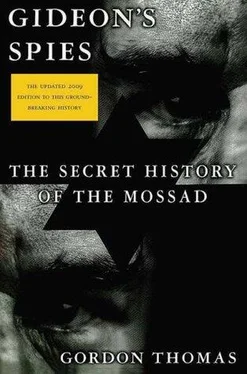Gordon Thomas - Gideon's Spies
Здесь есть возможность читать онлайн «Gordon Thomas - Gideon's Spies» весь текст электронной книги совершенно бесплатно (целиком полную версию без сокращений). В некоторых случаях можно слушать аудио, скачать через торрент в формате fb2 и присутствует краткое содержание. Город: New York, Год выпуска: 2009, ISBN: 2009, Издательство: Thomas Dunne Books, Жанр: История, на английском языке. Описание произведения, (предисловие) а так же отзывы посетителей доступны на портале библиотеки ЛибКат.
- Название:Gideon's Spies
- Автор:
- Издательство:Thomas Dunne Books
- Жанр:
- Год:2009
- Город:New York
- ISBN:978-0-312-53901-6
- Рейтинг книги:4 / 5. Голосов: 1
-
Избранное:Добавить в избранное
- Отзывы:
-
Ваша оценка:
- 80
- 1
- 2
- 3
- 4
- 5
Gideon's Spies: краткое содержание, описание и аннотация
Предлагаем к чтению аннотацию, описание, краткое содержание или предисловие (зависит от того, что написал сам автор книги «Gideon's Spies»). Если вы не нашли необходимую информацию о книге — напишите в комментариях, мы постараемся отыскать её.
Gideon’s Spies
Gideon's Spies — читать онлайн бесплатно полную книгу (весь текст) целиком
Ниже представлен текст книги, разбитый по страницам. Система сохранения места последней прочитанной страницы, позволяет с удобством читать онлайн бесплатно книгу «Gideon's Spies», без необходимости каждый раз заново искать на чём Вы остановились. Поставьте закладку, и сможете в любой момент перейти на страницу, на которой закончили чтение.
Интервал:
Закладка:
That fusing began after the October War in 1973 when Israel had been seriously threatened by superior Arab forces. To ensure that could never happen again, Washington had provided the Jewish state with a level of support far greater than it had given to any other nation. Since then, Israel had received over $3 billion in direct assistance—worth about $500 a year for every Israeli man, woman, and child. The largesse was particularly striking as Israel was, by the new millennium, a wealthy industrial country with a per capita income equal to that of Spain or South Korea. Other countries in receipt of U.S. foreign aid tend to receive the money in quarterly installments. Israel, on the other hand, gets its entire appropriation at the start of each fiscal year. This enables Israel to earn valuable interest on the stock markets of the world using money it will only later drawdown.
There are other terms which give Israel “favored status.” It is allowed to use 25 percent of its allocation to subsidize its own defense industry; again, no other nation is allowed to use U.S. funds for that purpose. Neither does Israel have to account for how the money is spent; this makes it hard for Washington to prevent the allocation being only partly used for purposes, which Israel opposes, such as building settlements on the West Bank. Moreover, Washington has encouraged Israel’s burgeoning defense industry to use a substantial amount of the annual budget it provides to develop the latest weapons systems. Some of these have been created from material stolen from the United States (see chapter 10, “A Dangerous Liaison”). The United States has also given Israel, at production costs, Black Hawk helicopters and F-16 jets. To top it all off, it has given the Jewish state vital intelligence it refuses to share with its NATO allies and has continued to allow Israel to increase its arsenal of nuclear weapons.
On the day their aircraft headed out from Ben Gurion airport, the men in their First Class armchairs would have seen on their left the distant outline of Dimona, the country’s nuclear facility where over two hundred kinds of nuclear weapons were stored in 2006.
Equally important, successive U.S. administrations provided Israel with invaluable diplomatic support. Since 1982 the United States vetoed thirty-two significant resolutions critical of Israel: this was more than all the numbers of vetoes cast by all the other Security Council members. U.S. diplomatic support had also included blocking the efforts to put Israel’s nuclear arsenal on the International Atomic Energy Agency’s agenda—which would have laid Dimona open to inspection. Time and again America supported Israel in time of war and used its influence when negotiating peace. Successive U.S. administrations had protected Israel against Soviet threats and later played a crucial role in the 1993 Oslo Accords. Meir Amit, the former Mossad chief and in 2006 still an “elder” of the intelligence community, recalled (to the author): “There may have been occasional bumps along the way, but Washington consistently supported our position.” Rafi Eitan, Mossad’s retired director of operations and in 2006 the head of a small political grouping of pensioners in the Knesset, remembered: “Time and again Israel has found Washington functioning as our unpaid lawyer on the world stage.”
Eitan was among those who believed that Israel, for its part, had been a “valuable asset” to the United States during the Cold War. “In many ways we had acted as Washington’s proxy by helping to contain Soviet expansion in the region and inflicting heavy defeats on Soviet client states like Egypt and Syria. We had also helped to protect another U.S. ally, like Jordan, and, of course, we passed on important intelligence about Soviet intentions.”
But Israel had also provided sensitive military technology, either sent directly from the United States to the Jewish state or developed within its own defense industry, to countries like China and South Africa. The State Department’s inspector-general had described this as “a systematic, and continuing to grow, pattern of unauthorized transfers. Israel also remains the most aggressive in running operations against the U.S. of any ally.”
Since 9/11 Israel and the United States has become even closer enjoined—“like identical twins” Meir Dagan said—due to the war against terrorism. Part of that relationship has been to allow Tel Aviv a free hand on how it would deal with Hamas in the Gaza Strip and Hezbollah’s threat on Israel’s northern border.
It was against that background that the Houston discussions began. Much of the initial tension revolved around Uri Saguy. While he was seen in Israel as a hawk who had turned dove and the first to detect what he called “a sea of change in Damascus,” it was a judgment which made him unpopular in Israel together with his argument that the Golan Heights must be surrendered. But to Fatah he was also the man who had approved Mossad assassinations including attempts on Yasser Arafat’s life. Jibril Rajoud, for one, felt that “the jury is still out” on how Arafat had died. “Natural causes or murder, we may never now know,” he said.
At the end of each meeting, using secure communication links provided by the U.S. State Department, Rajoud reported to President Mahmoud Abbas and Saguy briefed Ehud Olmert. That briefing, by agreement, had included Meir Dagan. It was in every sense Olmert’s first real taste of international politics. The rise of the sixty-one-year-old lawyer had been meteoric as it was unexpected. Injured while serving in the Israeli Defense Forces as a combat officer, Olmert had completed his military service as a journalist on the Force’s BaMahne magazine. An untaxing position, it also had an unforeseen benefit. During the Yom Kippur War of 1973, Olmert joined General Ariel Sharon’s headquarters as a military reporter. Sharon took a liking to the tall Olmert in his carefully pressed uniform and shoulder pip, which identified him as a lieutenant. Others saw him as “arrogant, cold, cunning, and unpleasant.” That judgment, by Israeli’s historian Tom Segev, would follow Olmert after he took a law degree at the Hebrew University in Jerusalem and opened a successful law partnership. From there it was but a step into political life. In 1973, at the age of twenty-eight, he became the youngest member of the Knesset. “I was often impetuous and wrong in the early years,” he later admitted. He opposed Israel’s withdrawal from the Sinai land captured in the Six-Day War and had voted against the Camp David Peace Accords in 1978. The year before, he had also been embroiled in a political finance scandal involving Jerusalem businessmen, organized crime, and corrupt legislators. Though he was later acquitted, he was unable to shake off his image of a fat-cat lawyer tainted by sleaze.
On the February day the negotiators had flown out to Houston, an inquiry was announced into the 1999 sale and leaseback of Olmert’s Jerusalem house in allegedly questionable circumstances. But soon events brewing in Lebanon would see the investigation firmly placed on the back burner of Israel’s legal system. In the meantime, Olmert had become a rising, but colorless politician, holding portfolios that included health, communications, and finance until, in 2003, he became Sharon’s deputy prime-minister. By then he learned to control his temper with reporters and had cultivated an air of being shrewd. Benjamin Netanyahu, the new leader of Likud, the party Sharon had left to form Kadima, said that Olmert is “a very clever guy.” Certainly, while withdrawal went against Olmert’s hawkish views, he also now believed it was the only response to the changing demographics of a growing Palestinian population which could eventually outvote Israelis.
Читать дальшеИнтервал:
Закладка:
Похожие книги на «Gideon's Spies»
Представляем Вашему вниманию похожие книги на «Gideon's Spies» списком для выбора. Мы отобрали схожую по названию и смыслу литературу в надежде предоставить читателям больше вариантов отыскать новые, интересные, ещё непрочитанные произведения.
Обсуждение, отзывы о книге «Gideon's Spies» и просто собственные мнения читателей. Оставьте ваши комментарии, напишите, что Вы думаете о произведении, его смысле или главных героях. Укажите что конкретно понравилось, а что нет, и почему Вы так считаете.












